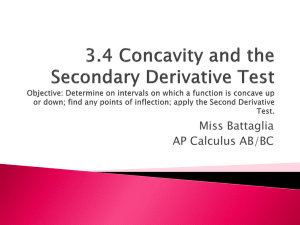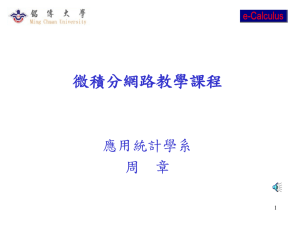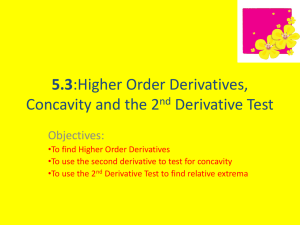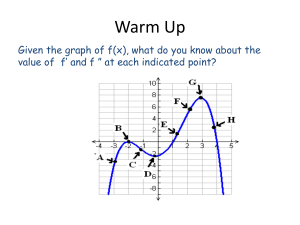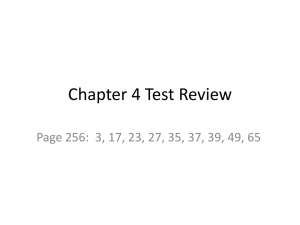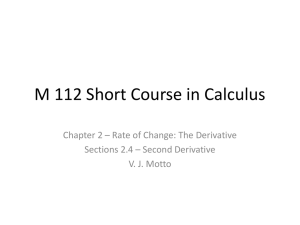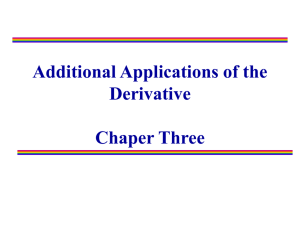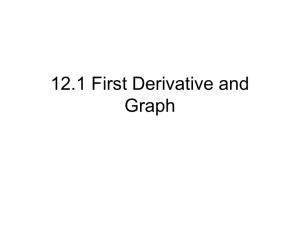Concave Up
advertisement
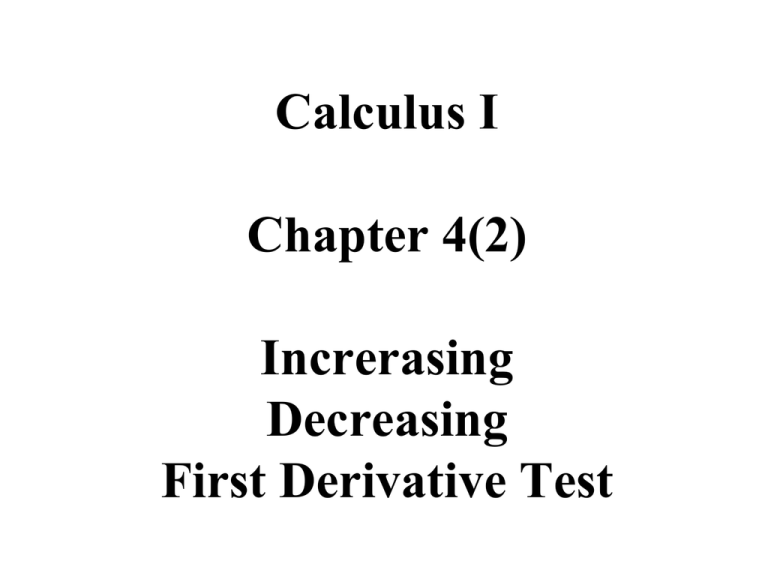
Calculus I Chapter 4(2) Increrasing Decreasing First Derivative Test Increasing & Decreasing Functions A function is Increasing between two points if the y-value of the second point is greater than the y-value of the first point. A function is Decreasing between two points if the y-value of the second point is lower than the y-value of the first point. Give the intervals where the function is increasing, decreasing, and constant a b c d e f g h i Increasing intervals: (a, b) (c, e) ( g , h) (i, j) Decreasing Intervals: (b, c) ( f , g ) (h, i) Constant Intervals: (e, f ) j Derivatives and increasing & Decreasing Functions A function is Increasing at a point if the derivative is positive at the point (tangent line is going up) A function is Decreasing at a point if the derivative is Negative at the point (tangent line is going down) Steps for finding where a function is increasing & decreasing Find the Critical Values (when f’(x) = 0) Graph the Critical values on a number line Check the intervals in f’(x) to see if Positive – Increasing Negative - Decreasing Find the increasing intervals and the decreasing 2 intervals for: f ( x) 8x 2 x Find Critical Values (derivative = 0) f '( x) 8 4 x 2 8 4 x 0 so x 2 Put Critical Value(s) on a number Line: F(x) is Increasing Put a # from the left side (1) into the derivative f (1) 8 4(1) Positive Positive means increasing F(x) is Decreasing 2 Put a # from the right side (3) into the derivative f (3) 8 4(3) Negative Negative means Decreasing (-,2) is Increasing, (2, ) is Decreasing First Derivative Test If f’(x) changes from negative to positive at some point c, then f(x) is a relative minimum. Positive Derivative Negative Derivative Relative Minimum If f’(x) changes from positive to negative at some point c, then f(x) is a relative maximum. Relative Maximum Positive Derivative Negative Derivative Steps for finding relative max & min Find the Critical Values (when f’(x) = 0) Graph the Critical values on a number line Check the intervals in f’(x) to see if Positive – Increasing Negative - Decreasing Increasing to Decreasing - Max Decreasing to Increasing - Min Find the local extrema, the increasing intervals and the decreasing intervals for: f ( x) x3 6x2 15 3x 12 x 0 2 Find Critical Values 3x( x 4) 0 so x 0 & 4 (derivative = 0) Put Critical Value(s) on a number Line: F(x) is Increasing Pick -1 0 f (1) ( Neg )( Neg ) Positive F(x) is Decreasing Pick 1 F(x) is Increasing 4 Pick 5 f (1) ( Pos)( Neg ) f (5) ( Pos)( Pos) Positive Negative (-,0) U (4,) is Increasing, (0, 4) is Decreasing (0, 15) Max, (4, -17) Min Find the local extrema, the increasing intervals and the decreasing intervals for: f ( x) x 3 Find Critical Values x2 x 2 (1) ( x 3)(2 x) 0 2 2 (x ) ( x 6) 0 so x 6 & 0 3 x (derivative = 0) Put Critical Values on a number Line: F(x) is Decreasing Pick -7 f (7) F(x) is Increasing -6 Neg ( Neg ) Neg Negative Pick -1 f ( 1) Neg ( Pos ) Neg Positive F(x) is Decreasing 0 Pick 1 f (7) Neg ( Pos ) Pos Negative (-,-6) U (0,) is Decreasing, (-6, 0) is Increasing x = 0 Vertical Asymptote, (6, -1/12) Min Concavity A graph is Concave Up on an interval if f’ is increasing on the interval. A graph is Concave Down on an interval if f’ is decreasing on the interval. f(x) Draw the derivative graph and indicate where the graph is concave up and concave down and where it is increasing and decreasing. f(x) a b c d e f g f ' ( x) Concave Up (a, c) Concave Down (c, e) U (e,f) Increasing (b, d) U (e ,f) Decreasing (a, b) U (d ,e) U (f ,g) Second Derivative and Concavity A graph is Concave Up on an interval if f ( x) is positive on the interval. A graph is Concave Down on an interval if f ( x) is negative on the interval. f(x) f ( x) Inflection Point An Inflection Point is a point where the concavity changes This is where the second derivative = 0 or is undefined Steps for finding where a function is Concave Up or Down Find the second derivative and set it = 0 Graph the resulting values on a number line Check the intervals in f ( x) to see if Positive – Concave up Negative – Concave Down Find the inflection points and where concave up & down: f ( x) e x / 2 2 Find Second Derivative Values f ( x) xe x2 / 2 f ( x) e x2 / 2 Inflection ( x2 1) so x 1 Put Inflection points on a number Line: Concave Up Pick -2 f (2) ( Pos)( Pos) Positive Concave Down -1 Pick 0 Concave Up 1 Pick 2 f (0) ( Pos)( Neg ) f (2) ( Pos)( Pos) Positive Negative (-,-1) U (1, ) is Concave Up, (-1,1) is Down Second Derivative Test If f (c) 0 for some value of c, and f (c) 0 then c is a minimum point on the graph of f(x) Concave Up Relative Minimum If f (c) 0 for some value of c, and f (c) 0 then c is a Maximum point on the graph of f(x) Relative Maximum Concave Down Find the Extrema and inflection points and give the 5 3 f ( x) 3x 5x concavity intervals for: Find both Derivatives and set =0 f ( x) 15x4 15x2 15x2 ( x2 1) so x 0, 1 3 f ( x) 60 x 30 x f ( x) 30x(2x2 1) x0 & 1 2 Put all Points on a number Line and finish:

